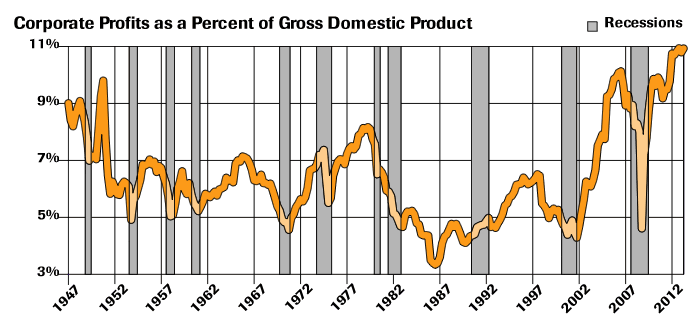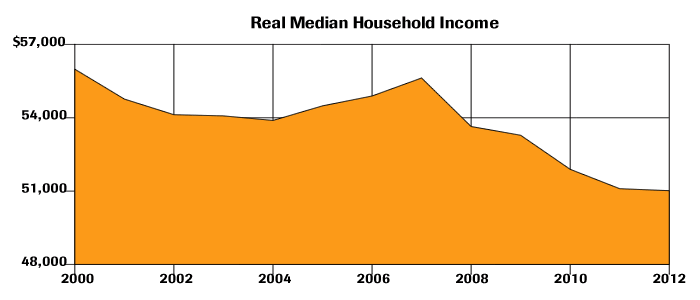2013 Q3 | Waiting on Washington: A Nation Adrift
 The United States and the world suffered through a miserable quarter of political and economic disappointments. The Arab Spring turned into an Arab nightmare as Egypt’s President Morsi was ousted in a military coup, leaving the country in a state of civil unrest. Citizens of neighboring Syria, suffering through a seemingly endless civil war, were unbelievably subjected to a ruthless poison gas attack that killed fourteen hundred people, many of them children. A stunned world watched as President Obama’s threatened missile retaliation was averted at the eleventh hour by the almost fictional villain, former KGB Chief and now Russian President Vladmir Putin, who brokered a deal for peace in exchange for the destruction of Syria’s chemical weapons stockpiles. In late September, there was an Al-Qaeda-led massacre in a Kenyan shopping center. Kenya, we believed, is one of the more peaceful nations in Africa. Finally, a deranged man attacked the Naval Shipyard in Washington, resulting in twelve deaths.
The United States and the world suffered through a miserable quarter of political and economic disappointments. The Arab Spring turned into an Arab nightmare as Egypt’s President Morsi was ousted in a military coup, leaving the country in a state of civil unrest. Citizens of neighboring Syria, suffering through a seemingly endless civil war, were unbelievably subjected to a ruthless poison gas attack that killed fourteen hundred people, many of them children. A stunned world watched as President Obama’s threatened missile retaliation was averted at the eleventh hour by the almost fictional villain, former KGB Chief and now Russian President Vladmir Putin, who brokered a deal for peace in exchange for the destruction of Syria’s chemical weapons stockpiles. In late September, there was an Al-Qaeda-led massacre in a Kenyan shopping center. Kenya, we believed, is one of the more peaceful nations in Africa. Finally, a deranged man attacked the Naval Shipyard in Washington, resulting in twelve deaths.
Adding to this terrible litany of global woes, the domestic economy experienced its own challenges. The city of Detroit declared bankruptcy and Congress continued to squabble over the federal budget and the implementation of President Obama’s signature legislation, the Affordable Care Act. Unemployment rates remained stubbornly high and it is estimated that 50% of the individuals hired in the last 18 months were part time employees, as employers adapted to the added health care expenses mandated by the Affordable Care Act. All of these things occurred as federal budget issues and debt ceiling limits continued on course to crisis.
Amazingly, the stock market advanced 5.28% in the quarter, adding to the gains scored in the first half of 2013. The S&P 500 is now up 20.0% from year-end 2012, well above the 10% returns experienced in an average year. Strong earnings
growth supported the good result in the stock market. But revenue growth in recent quarters has trailed the reasonably strong profit growth, and as noted in previous quarterly letters, this divergence must close at some point.
The slow growth rate of sales is consistent with the modest economic recovery of approximately 2% in real Gross Domestic Product in the first three quarters of 2013. But slower sales growth accompanied by stronger profit growth resulted in an increase in corporate profit margins. In fact, after-tax corporate profits as a percent of GDP are at an all-time high, eclipsing the halcyon levels of the mid-1960s (see chart, page three). Also, cash continues to pile up on corporate balance sheets, now well above $1.7 trillion, due to the reluctance of corporations to invest because of many economic and world uncertainties. To put it mildly, the Obama Administration is not perceived as business friendly, and the corporate sector has become very cautious in its expansion planning.
Another major factor restricting business spending may be the Federal Reserve’s mixed signals over the past nine months. Last December, the Federal Reserve modified the conditions necessary for monetary easing. In addition to an inflationary test of 2%, the Fed added another metric for easing, a 6.5% unemployment rate. With the latest 12 month inflation rate of 1.5% and an unemployment rate of 7.3%, there seems little likelihood of the Fed increasing the Fed Funds rate any time soon. The quantitative easing program has been adding $85 billion a month to the country’s money supply since September of 2012, and has been a primary contributor to the modest economic growth the country has been experiencing. In June, Chairman Bernanke suggested a “tapering” might be appropriate. His remarks triggered a sharp increase in the 10-year Treasury bond rate and a corresponding fall in bond prices in July and August.
Further complicating the policy is the impending change of leadership at the Federal Reserve. Mr. Bernanke’s second seven-year term will end in January 2014. Although eligible for another term, the Obama administration has clearly stated its preference for a new chairman, and Mr. Bernanke has signaled his willingness to leave. Although giving the appearance of an amicable changing of the guard, one never knows in Washington. What isn’t uncertain is that a political struggle for succession began in the spring between Fed Governor Janet Yellen and former Treasury Secretary Larry Summers. Both contenders waged a very public campaign for the office in the press. In what became an almost daily story in The Wall Street Journal and The New York Times, competition for the office became personal and ugly. Although the most qualified and President Obama’s favorite, Summers alienated a number of important Democratic constituents while he served as the president of Harvard (2001-2006). In early September, Summers withdrew his name from consideration. But scars still remain, and a rocky confirmation process may be ahead for the ultimate nominee.
For a number of reasons, our firm’s positive outlook for financial assets has been tempered (maybe tapered!) during the summer. Although we have been cautious on bonds and interest rates for more than a year, we have been surprised by the speed and degree of increase in the 10-year Treasury yield. As a result, 30-year mortgage rates rose from 3.4% in October of 2012 to 4.4% in July of this year. The principal and interest payments on a $200,000 mortgage increased from $887 per month to $1,101 per month. This, coupled with an 18-22% increase in median house prices in many markets means that monthly payments on a typical $200,000 house could be up 30% year over year, enough to threaten the housing recovery. With median household income stagnant over the last several years (see chart, back page), a jump in monthly housing payments could stall the recovery.
[blockquote4 align=”left|center|right” textalign=”left|center|right” width=”30%”]For a number of reasons, our firm’s outlook has been tempered (maybe tapered!) during the summer.[/blockquote4]A second crisis to befall the bond market was the July 19 bankruptcy filing by the city of Detroit and the default of all of the city’s municipal debt issuances, around $18 billion. The debt default was the result of the Great Recession, a near collapse of the city’s principal industry (automobiles), gross mismanagement, and rampant corruption.
Investment analyst Meredith Whitney predicted serious problems ahead for the entire municipal debt market in her now-famous appearance on 60 Minutes in December 2010. In 2012, a number of smaller municipalities, including Stockton, CA, San Bernardino, CA, and Jefferson County, AL, defaulted, but the sums involved were minor. Although Mrs. Whitney’s forecast was dismissed at the time in many quarters, the Detroit filing has raised warning flags across the entire municipal debt spectrum.
We continue to recommend caution with respect to fixed income assets, specifically we would avoid maturities beyond five years and would await better opportunities, as interest rates are expected to rise. But the municipal defaults remind us that there are two risks to bond investors. The first: that a rise in rates will result in a fall in bond prices. This can be addressed by maintaining short maturities. But Detroit introduces the second risk: the risk of default, which is a much more serious risk in terms of potential loss. A primary defense against default risk is the independent rating agencies such as Moody’s and Standard & Poor’s. We must place our faith in these agencies and hope that they have learned from the mistakes they made in the 2008-2009 credit crisis.
Finally, we face the spectacle of our government seemingly unable to govern. This subject is being dealt with last because this letter is being written on September 30, and it is not clear as to the outcome of the budget and debt negotiations, which will have a significant influence on our economy and markets in the very near future.
[blockquote4 align=”left|center|right” textalign=”left|center|right” width=”30%”]With median household income stagnant over the last several years, a jump in monthly housing payments could stall the recovery.[/blockquote4]The first of two critical deadlines facing the nation is on October 1, when the government budget authority expires. Absent new legislation, the government will shut down as it did in December 1995. A second critical date will occur in mid-October when the borrowing authority needed to fund our deficit spending will be exhausted. The un-statesmanlike conduct of the President, the Democrats, and the Republicans is unworthy of a nation that is as strong as ours. It is time to end the petty bickering, to put the country first, and to ask our political leaders to act responsibly.
As previously noted, equities advanced in the quarter. The S&P 500 index twice achieved our target of 1,700 for 2013. Our target for the Dow Jones Industrial Average is 16,000 to 16,500 and the indexes came within 1 or 2% of that target. Valuations now appear to be reflecting current economic and earnings expectations. It has been some time since we have had an even minor correction of 5-10% in stock prices and without renewed sales momentum, profit growth could slow or even fall, depriving the market of the oxygen it needs to advance. We have begun trimming some of our equity positions as a number of stock price targets have been exceeded.
[blockquote4 align=”left|center|right” textalign=”left|center|right” width=”30%”]We continue to recommend caution with respect to fixed income assets.[/blockquote4]Many years ago, Alex Brown & Sons was managed by two wonderful gentlemen: senior partners Benjamin H. Griswold III and Charles S. Garland, Sr. As a young lad of eighteen, completing a summer internship in the summer of ’65, I was invited to have lunch with Mr. Garland before returning to college. After reporting on my summer duties and what I had learned, Mr. Garland asked me: “What do you think the stock market will do?” Note: the stock market had been rising more or less steadily since the end of World War II and was at an all-time high with the Dow at 939 (Yes, 939!). I responded to Garland’s question: “Oh, Mr. Garland, the stock market always goes up.” He said, “Now Jim, the stock market is like a marathon runner. Every time he makes a run, he doesn’t always set a new record, but a runner like our economy, if he stays in shape, will eventually break his old records.” He added, “You know, the market has been rising for a number of years and may need a rest.” The market went on to establish an all-time closing high of 995 in February of 1966. That was a record closing that was not to be decisively broken until October of 1982, nearly a seventeen year drought. Sadly, Mr. Garland was to die in January 1971, never to see the market close above 1,000.
Today our stock market may need a “rest,” but I would be quite surprised if it is a seventeen year break before we see a new sustainable high in share prices. Our economy may be resting for now, but there are any number of our economic sectors that are strengthening their corporate bodies and will one day, hopefully soon, go on to a new series of economic records and stock highs. I, for one, am expecting and counting on America’s economic leadership. What we have done before, we will do again.





